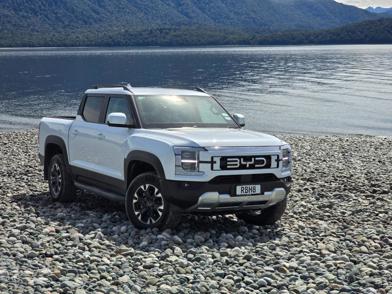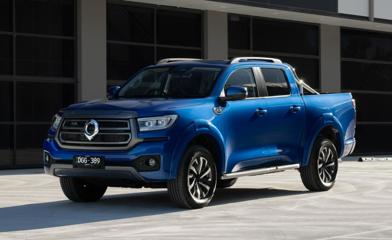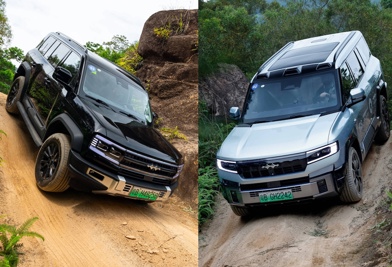What’s this new car all about then?
Often the best vehicles are actually answers to questions you didn't even know needed asking. Take the Ford Ranger Super Duty, for example; the standard Ford Ranger is a superbly capable ute that ticks many boxes for many people and, with the right aftermarket tweaking, can do almost anything you would want.
Hidden in that statement is the question though; why should you have to spend more money after purchasing the ute to make it suit your needs better?

That is exactly what Ford Australia thought, and it's answer is the Ranger Super Duty, which marks an aggressive move by the company to redefine the capability ceiling of the midsize pickup segment.
Engineered entirely by Ford Australia, the Super Duty edition of the venerable Ranger represents a culmination of years of customer research, intense engineering effort, and a commitment to earning one of Ford’s toughest global brand badges.

The Super Duty badge was established by the F-Series line in North America, and is not given out lightly for anything outside that. As such, the Ranger Super Duty team had to convince the company that the new vehicle lived up to the Super Duty DNA.
Earning the badge required treating the Ranger Super Duty as essentially a different program off the global Ranger platform, demanding significant funding and engineering changes from the standard Ranger, as the Super Duty had to meet massive capability targets.
Ford says the Ranger Super Duty is an "uncompromising solution" aimed at customers who require capability beyond what a standard midsize ute can offer, but without having to resort to the enormous size of big American pickups or the rather utilitarian extremes of the likes of the Toyota Land Cruiser 70 Series.

In fact, it is the Toyota that Ford is specifically taking aim at, with the venerable Land Cruiser being a favourite of mining companies, rural fire and rescue services, and enormous sheep and cattle stations across Australia. And Ford wants a chunk of that market.
The underbody protection is so strong that Ford engineers says that the Super Duty can actually be completely supported on a rock by the 4mm-thick bash plate that protects the fuel tank.
To achieve this uncompromising solution Ford has extensively re-engineered the Ranger's platform, to the point that the Super Duty's chassis is almost entirely new, with only about 6 percent of the frame carrying over from the standard Ranger.

The Super Duty chassis is thicker and stronger with increased crossmembers and extensive underbody protection. In fact, the underbody protection is so strong that Ford engineers says that the Super Duty can actually be completely supported on a rock by the 4mm-thick bash plate that protects the fuel tank.
The suspension geometry has also been stretched, with the mounting points for the heavy duty rear leaf springs placed much further forward and rearward than the standard Ranger, specifically to enhance stability during heavy towing, while heavy duty 18-inch brakes are significantly uprated to handle the Super Duty's 8 tonne GCM.
Yes, that's right, the Ranger Super Duty has a Gross Combined Mass of a colossal 8000kg, while its Gross Vehicle Mass (GVM) is 4500kg and its maximum towing capacity is rated at 4500kg. Oh, and the Super Duty has a maximum payload of around 1900kg (depending on model, tray, etc), meaning that you could hook a 3.5 tonne trailer on it, throw a tonne on the tray and still load four regular-sized adults in the cab with capacity to spare.

The Super Duty was even subjected to double durability testing, equivalent to two full 10-year life cycles, to ensure absolute robustness. During testing, the engine mounts experienced up to seven times the loads seen on a standard Ranger when operating off-road at 4.5 tonnes GVM.
Unladen handling is genuinely impressive, with the Super Duty carrying speed through corners even more competently than the standard Ranger, despite its heavy duty suspension and all-terrain tyres.
Under the bonnet, the 3.0-litre turbo diesel V6 diesel engine has been specifically retuned for the heavy-duty application. The Super Duty's 8 tonne GCM sees it needing to meet Heavy Duty EUVI emission standards, which sees it losing power over the standard V6 (154kW versus 184kW), but retaining 600Nm of torque at 1750rpm.

Inside, the cabin maintains the comfort, technology, and refinement found in the Ranger, and includes a 12-inch touchscreen infotainment system, with Apple CarPlay and Android Auto, as well as the standard suite of driver assistance technologies.
However, the Super Duty is deliberately outfitted for hard work, featuring durable cloth seats and hard-wearing vinyl flooring. Based on customer feedback, the automatic stop/start function was deleted because certain fleet applications (like mines) require the vehicle to be continuously running for tracking systems.
One tech feature that standard Ranger doesn't see is the Super Duty's onboard scales and Smart Hitch feature that use ride height sensors to help customers properly distribute and optimise their load, which is critical given the common problem of customers overloading their vehicles when towing caravans.

How much is it?
While Ford has yet to announce New Zealand pricing, Australian pricing starts at AU$82,990 for the single cab chassis Ranger Super Duty and rises to AU$89,990 for the double cab chassis, with a super cab version sitting in between at AU$86,490.
While the initial throttle response is noticeably less eager than the standard V6, it all just generally feels like a Ranger. Just tougher.
These prices happen to be in line with Toyota Australia's pricing for the Land Cruiser 70 Series, so if Ford NZ takes a similar approach, then the Super Duty will be around NZ$80,000 to NZ$90,000 depending on model.

The standard paint colour is Arctic White, with priced options including Shadow Black, Command Gray, Seismic Tan, and Aluminium Metallic, and customers can also choose from three Ford FLA steel trays: galvanised, matte black, or body coloured.
What’s it like to drive?
Remarkably good, considering what it is capable of.

First impressions are... it's a Ranger. The interior is largely the same (save for the cloth seats, vinyl floor, and massive SUPER DUTY wording embossed in the dash), as is the subdued rumble of the diesel V6. The ride is slightly truckier once up and moving, while the initial throttle response is noticeably less eager than the standard V6, but it all just generally feels like a Ranger. Just tougher.
While it is genuinely impressive both in terms of handling and handling a big load, off-road is where the Super Duty simply blows you away.
Throw a load on the back and nothing really changes. The massive capacities the Super Duty can handle means that it really doesn't care what you chuck on the back (either in the tray, on the tow bar, or both) until you start approaching the maximums. Even then it feels pretty much unbothered, just a bit slower.

Unladen handling is genuinely impressive, with the Super Duty carrying speed through corners even more competently than the standard Ranger, despite its heavy duty suspension and all-terrain tyres. This is no doubt thanks to the Super Duty's wider stance (it is as wide as a Raptor) and increased stability due to the rear leaf spring mounts being moved out further.
While it is genuinely impressive both in terms of handling and handling a big load, off-road is where the Super Duty simply blows you away.
Compared to the standard Ranger, the Super Duty boasts a new transfer case, drive shafts, prop shafts, half shafts, and new front and rear differentials. The 2WD option has been dropped from the rotary dial, with the Super Duty only using 4WD Auto, 4WD High and 4WD Low, with a number of terrain select modes available as well.

Throw in front and rear locking differentials and an utterly relentless "Trail Assist" crawl mode (essentially a low-speed off-road cruise control system) and the Super Duty is almost literally unstoppable.
The Ranger Super Duty is engineered to solve a problem that current one-tonne utes simply cannot address, putting it in a unique space.
In fact, low range almost becomes a last resort option, as leaving the Super Duty in 4H and lugging it along with Trail Assist is every bit as capable as dropping it into 4L and using the gears to achieve a similar effect, but considerably smoother.

Of course, the Super Duty also boast massive axle articulation, an unladen ground clearance of between 295mm and 299mm (depending on body style), an 850mm wading depth (with the sealed snorkel system that is standard on Australian vehicles, but an option in New Zealand), and approach, breakover and departure angles of 36, 29 and 13.6 degrees respectively (with tiny variations between body styles).
What’s the pick of the range?
You don't have much choice right at the moment, as the only real decision is between single cab, super cab or double cab, all in cab chassis configurations. The level of equipment is the same across all body styles, with an optional flat deck being available in either a galvanised finish, black finish or body coloured finish.

The up-spec XLT will be landing sometime around the middle of next year and will offer a wellside version as well as a cab chassis version. The XLT is being pitched more at the private buyer (who likely twos a huge caravan) and as such adds niceties like leather seats (with heating, cooling, and power adjustments), carpet flooring and unique 8-stud alloy wheels.
The Super Duty offers all the rugged off-road capability of the Toyota (Land Cruiser 70), but can carry more and tow more, with significantly more comfort, refinement and a car-like ride for good measure.
I mean, personally, a super cab with a body coloured flat deck appeals to my tastes, but regardless of cabin layout or colour choices, the Super Duty is a deeply impressive machine.

What other cars should I consider?
The Ranger Super Duty is engineered to solve a problem that current one-tonne utes simply cannot address, putting it in a unique space.
While the standard Ranger is already the benchmark in the one tonne ute segment, the Super Duty offers capability not matched by any other competitor actually in that segment, meaning that its more direct competition will come from outside the traditional ute sphere.

As such, Ford expects the Super Duty to draw business from a wider pool of customers, such as those currently using cab-over engine light trucks due to GVM limits, as well as - but to a lesser degree - full-size US pickups buyers, with the Super Duty delivering competitive towing and payload metrics, making it a viable alternative for the "serious recreational tower" who prefers the slightly smaller, more manoeuvrable footprint of the Ranger.
But the most direct competitor is that Toyota Land Cruiser 70 Series mentioned earlier. The Super Duty offers all the rugged off-road capability of the Toyota, but can carry more and tow more, with significantly more comfort, refinement and a car-like ride for good measure.
In fact the only hitch in the Super Duty plan is the fact that the massive GVM pushes it out of Warrant of Fitness checks and into Certificate of Fitness (CoF) territory and, if you plan on making the absolute most of its capabilities, then a Class 2 license will also become necessary.


































